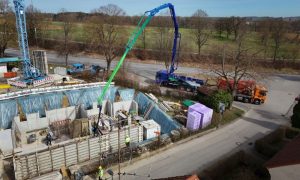Trimble advocates for digitisation to boost construction development in the Middle East
The firm says its solutions have been used to deliver a number of high-profile projects including the Museum of Future and the Burj Khalifa

Trimble announced that AEC firms have achieved up to 50% less rework, up to 30% higher machine productivity and up to 30% cost savings using its technology solutions. The firm said its customers were able to make informed decisions and saw up to a 30% increase in machine productivity and fuel savings, as per the firm’s latest report.
According to a statement from the firm, its solutions have also been contributing to the reduction of greenhouse gas emissions in the field by at least 553,964 tons per year. The firm noted GHG emissions reduced by using its solutions is equivalent to 109,294 passenger vehicles driven for one year. It added that the solution further supports the sector’s goals of cutting carbon footprint and contributing to the UN global goals towards sustainable development.
There has also been a wide improvement in meeting project deadlines, while enabling companies to significantly cut the environmental impact of their construction activities, the report said.
“Sustainability and digitalisation are two of the world’s leading trends that the region’s construction industry must incorporate to ensure sustainable growth. The AEC industry in the region is now waking up to the need to digitalise construction and is increasingly recognising its long-term benefits and business value. With the region’s construction industry projected to grow at an average annual rate of 3.8% by 2025, Trimble’s Connected Construction is responding to this projected demand. It puts forward an advanced method, which embraces the need for greater accuracy and efficiency for all construction industry players, which include architects, engineers, contractors and owners,” said Paul Wallett, regional director, Trimble Solutions – Middle East and India.
The firm said its Connected Construction solution is designed to improve the five key pillars of the construction industry’s operations, namely productivity, quality, transparency, safety, and sustainability.
The construction sector is rapidly catching up with the digital transformation across the world through ‘Connected Construction’. It unifies the people, processes, and phases involved in each project using the latest and most innovative hardware, software, and services, the statement added.
According to Trimble, a jobsite that is seamlessly connected through digital technology – from modeling, imagery, measurement, and data – to the physical world of stakeholders at each level of construction lifecycle and equipment, empowers construction companies. It enables them to manage with full confidence the sheer volume and scale of moving parts involved in large infrastructure projects. Connected construction further helps manage a project end-to-end, starting with pre-construction planning and continuing through its final handover, operations, and maintenance.
To further support the sector’s current needs, Trimble says it has introduced a new set of affordable subscription-based configurations of its flagship structural engineering software, Tekla Structures, to enable a larger number of AEC companies to adopt the technology.
Wallett concluded, “With a goal of making our technologies more accessible to small or mid-sized AEC firms who cannot always incur costs for perpetual licenses, we at Trimble have made a strategic shift towards subscription-based license models in March this year. Existing and new customers can now choose the most appropriate subscription plan and avail lower entry costs by using the Trimble solutions that are suited for them.”






















